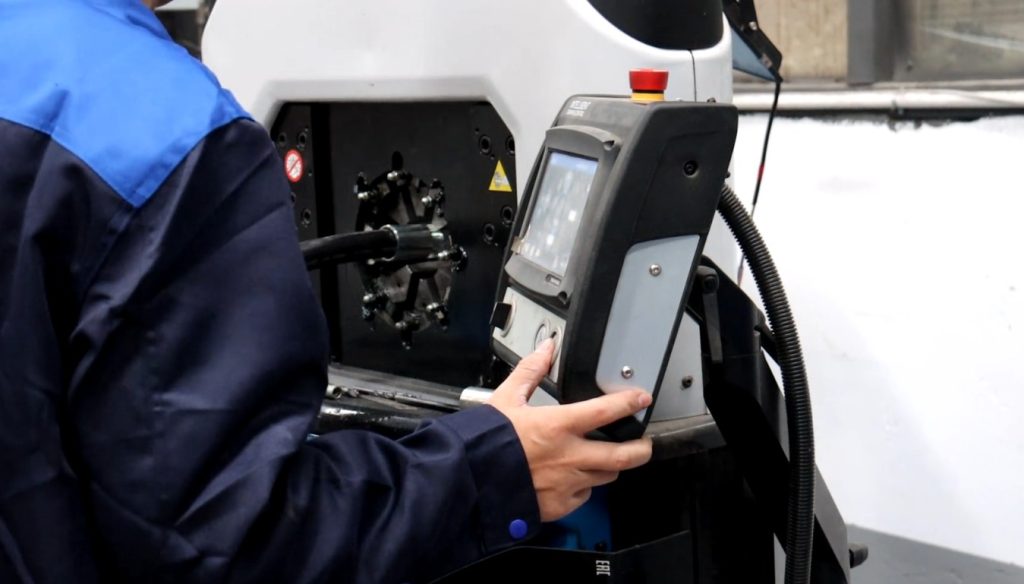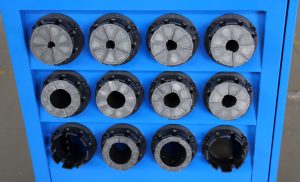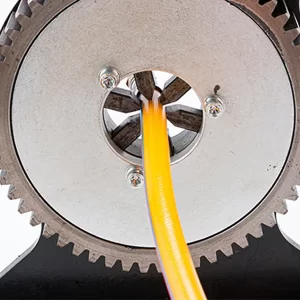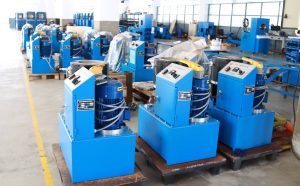1. What is a Hose Crimping Machine?
In industries like automotive, manufacturing, and construction, the importance of secure and reliable hose connections cannot be overstated. Whether you’re assembling hydraulic hose crimping systems, building brake lines for vehicles, or working on pneumatic crimping machinery, the safety and performance of your equipment depend heavily on the quality of these connections. A hose crimping machine is essential for ensuring that hose assembly components are securely bonded, preventing dangerous leaks and failures. These crimping machines for hoses are the unsung heroes in any system that relies on high-pressure fluid or air, where even the smallest flaw can result in costly repairs or catastrophic breakdowns. But what exactly is a hose crimping machine, and why are they so crucial for industries worldwide? In this post, we will dive into the mechanics, types, and applications of hose crimping machines, giving you a clear understanding of why they are essential to modern industrial operations.

2. Understanding the Essential Role of Hose Crimping Machines
At the heart of a hose crimping machine is its simple yet vital task: permanently securing hoses to fittings with a precise crimp that ensures a leak-proof connection. Without this process, systems can fail under pressure, leading to costly downtime and unsafe working conditions. Hydraulic hose assembly requires precision, and hose crimping technology ensures that hoses can handle the pressure, temperature, and movement they will face in real-world conditions. Hydraulic fitting crimping and hose connector crimping ensure that your hose assembly solutions are durable and secure. Whether you’re working with a manual crimping machine or a fully automated system, these machines guarantee the integrity of your hose crimped connections.
3. Why Hose Crimping Machines are Essential in the Industry
The consequences of not using a hose crimping machine are severe. Improperly crimped hoses can lead to dangerous leaks, weakened connections, and system failures, costing time, money, and possibly endangering lives. Crimping equipment like crimping dies provide the necessary pressure to bond hoses and fittings securely. Automatic hose crimping machines provide the precision necessary for consistent results, reducing human error and increasing productivity. From construction sites to automotive factories, hose crimping in manufacturing is critical in ensuring that high-pressure systems work reliably. The importance of hose connection security in these industries cannot be overstated, making crimping hydraulic fittings and hose sealing processes an essential part of assembly.
4. Types of Hose Crimping Machines
Choosing the right hose crimping machine for your specific needs can dramatically impact your productivity and precision. These machines come in various types, each designed to cater to different production volumes, hose fitting sizes, and application requirements.

5. Manual Crimping Machine: Simple, Effective, and Reliable
For businesses that focus on low-volume or custom hose assembly, manual crimping machines are a cost-effective solution. These crimping tools give operators full control over the crimping process, allowing for high levels of accuracy when working with a smaller range of hose sizes and materials. While they require more effort and time than automated machines, their reliability and simplicity make them a favorite in small workshops or for less frequent tasks.
6. Semi-Automatic Crimping Machine: Balancing Efficiency and Cost
Semi-automatic crimping machines offer a middle ground between manual and fully automatic options. They combine the benefits of automatic hose crimping with the flexibility of manual input. These machines are ideal for businesses with medium to high-volume production needs, providing faster results than manual crimpers while remaining more affordable than fully automatic systems. Crimping for automotive applications is common with these machines, offering both flexibility and consistency.
7. Fully Automatic Hose Crimping Machines: Advanced Technology for High Volume
When your business requires high throughput and maximum precision, fully automatic hose crimping machines are the best option. These machines operate with minimal human intervention, using sophisticated control systems to automatically select the right dies, adjust crimping pressure, and ensure uniform results every time. High-pressure hose crimping is best handled with these systems, as they can produce consistently reliable connections even in demanding applications.
8. Portable Hose Crimping Machine: Compact and Convenient Solutions
For fieldwork or mobile workshops, portable hose crimping machines provide a compact, lightweight alternative to larger models. These crimping tools are designed to be easy to transport and operate, allowing technicians to perform hose crimping on-site. Whether it’s for on-location repairs or small-scale operations, portable hose crimping machines offer convenience without sacrificing the quality of the crimp.
9. How Hose Crimping Machines Work
The process of crimping a hose may seem simple, but precision is key to ensuring a secure, leak-proof connection. Understanding how a hydraulic crimping machine works is essential for anyone involved in hose assembly. Here’s a breakdown of the crimping process.

10. The Crimping Process: Step-by-Step Breakdown
The process starts by inserting the hose and fitting into the crimping machine. The machine then applies pressure using hydraulic pressure testing or pneumatic crimping systems, which compresses the fitting onto the hose. The result is a tightly sealed connection capable of withstanding high-pressure hose crimping and hose pressure testing conditions. The machine automatically adjusts the crimping force to ensure the correct compression, which is vital for the longevity and reliability of the connection.
11. Key Components of a Hose Crimping Machine
A hose crimping machine is composed of several key components that work in harmony to achieve the desired result. These include the crimping die, which forms the crimp, the hydraulic or pneumatic system that provides the force, and the control system that manages the operation. Each component plays a role in ensuring that the crimp is performed with crimping precision and consistency.
12. The Role of Dies in Hose Crimping Machines
Dies are crucial in the crimping process, as they determine the shape and size of the crimp. The selection of the correct crimping die is essential for ensuring that the hose and fitting are securely connected without damaging the material. Die selection for crimping is one of the primary factors that dictate the quality of the final crimp, especially when dealing with complex hydraulic system integrity requirements.
13. Choosing the Right Hose Crimping Machine for Your Needs
Selecting the correct hose crimping machine is a key decision that impacts efficiency, cost, and safety. There are several factors to consider before making a purchase, ranging from the volume of production to the specific needs of your business.
14. Factors to Consider When Selecting a Hose Crimping Machine
Key factors include hose size compatibility, the type of fittings you’ll be working with, and the level of automation required. It’s also important to consider the machine’s maintenance needs, ease of operation, and cost-effectiveness. Make sure that the machine you choose fits the volume of work you expect and that it aligns with your overall operational goals.
15. Hose Fitting Sizes and Material Compatibility
Not all hose crimping machines can handle every type of hose. Some are designed specifically for smaller hoses, while others are built for larger diameters or specialized materials like rubber, steel-braided, or thermoplastic hoses. Ensuring compatibility between the machine and the materials you work with is essential for reliable and efficient hose assembly.
16. Crimping Machine Maintenance
Regular crimping machine maintenance is essential to keep your hose crimping machine running at peak performance. Proper care ensures the machine is calibrated correctly and can produce leak-proof hose assemblies consistently.
17. How to Maintain Your Hose Crimping Machine for Optimal Performance
Regular maintenance includes cleaning the hydraulic or pneumatic systems, inspecting the crimping die for wear, and lubricating moving parts. Keeping your machine clean and well-lubricated reduces the risk of mechanical failure and ensures smooth operation, ultimately saving you time and money in the long run.
18. Common Issues and Troubleshooting Tips
Common issues with hose crimping machines can include inconsistent crimping, mechanical malfunctions, or the wrong die selection. Understanding how to troubleshoot these problems—such as recalibrating the machine or replacing worn parts—is crucial for minimizing downtime and maintaining high productivity.
19. Benefits of Hose Crimping Machines
When used correctly, hose crimping machines offer numerous benefits, making them an indispensable part of hose assembly processes.
20. Increased Efficiency and Productivity
Automating the crimping process results in faster production times, fewer human errors, and more consistent results. This efficiency translates into higher productivity, allowing businesses to meet tight deadlines without compromising quality.
21. Enhanced Safety in Hose Assembly
A properly crimped hose ensures the connection is secure, reducing the risk of leaks, bursts, and other dangerous failures. This added level of safety is crucial, particularly in industries that deal with high-pressure hose crimping, where failure can lead to significant hazards.
22. Cost-Effectiveness and Reduced Waste
By ensuring that hoses are correctly crimped the first time, these machines reduce material waste and the need for costly repairs. Over time, the savings from fewer failed connections and lower labor costs can significantly offset the initial investment in the machine.
23. Applications of Hose Crimping Machines
Hose crimping machines are used in a wide range of industries, each benefiting from their unique ability to produce secure, leak-free connections. From hydraulic lines to brake systems, these machines are used wherever hose connections are needed.
24. Industries That Rely on Hose Crimping Machines
Industries such as construction, aerospace, automotive, and agriculture all rely on hose crimping machines for assembling hydraulic and pneumatic systems. These industries need to ensure that their systems are strong and secure to avoid failures that could halt operations or cause safety hazards.
25. Common Uses in Hydraulic, Pneumatic, and Automotive Systems
Whether you’re assembling hydraulic lines for construction machinery, pneumatic systems for factory automation, or brake lines for vehicles, hose crimping machines are crucial for creating the secure connections that make these systems function properly.
26. Conclusion
Hose crimping machines are much more than just another piece of industrial equipment. They are essential to the safety, efficiency, and reliability of any system that relies on hose connections. From manual crimping machines to fully automatic hose crimping machines, selecting the right machine for your needs is key to improving productivity, reducing costs, and ensuring the longevity of your systems. By understanding how these machines work and investing in the right one for your application, you’ll be setting your business up for success in the long run.




